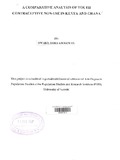| dc.description.abstract | Information on youth sexual behavior has significant policy implication in designing and implementing family planning and HIV/aids programs. The study therefore, set out to investigate the determinants of contraceptive non-use among sexually active youth aged 15-24 years in Kenya and Ghana. Specifically, the study sought to determine the major demographic, socio-economic and cultural factors affecting non-use with or without unmet need among youth in the two countries.
The study is organized into five chapters. Chapter one entails general introduction, problem statement, research questions, objectives, justification and limitation of the study. Chapter two; literature review and theoretical framework, Chapter three entails data and methods while chapter four and five comprise of multivariate analysis and research implications respectively. The study population consisted of 2132 and 1254 sexually active women aged 15-24 years, sampled in the KDHS and GDHS, 2003. The study variables were highest level of education, age, marital status, place of residence, media exposure, religion, region of residence and ethnicity while the dependent variable was contraceptive non-use.
Preliminary analysis included frequencies and cross tabulation. Chi-square test was also conducted to establish the statistical significance of the association among variables at 95 percent confidence interval while main analysis involved binary logistic regression. In both countries, the study revealed that there was a strong relationship between contraceptive non-use and the category of female youth who reported that they were aged 15-19, living in the rural areas, not educated and not exposed to mass media. Marital status and religion were only significant in Kenya and Ghana respectively. All the six hypotheses tested in the study were confirmed except the hypothesis that married youth are more likely to use contraception than unmarried youth that was rejected in Ghana.
The major conclusion derived from the study findings is that although levels of exposure to family planning were very high among the young women across the two countries, various socio-cultural, socio-economic and demographic factors influenced the youth contraceptive non-use. The main policy implication of this study is that concerted efforts should be made to improve the youth educational attainment and literacy levels, raise secondary school completion rates for girls and narrow social and gender biased differential in access to raise age at first marriage and shape young women’s attitudes towards reproductive health opinions and values, thereby creating favorable atmosphere, hence acceptance of family planning methods.
There is gap between knowledge and practice. Studies indicate that adolescent have acquired knowledge and awareness on reproductive health including contraceptive use and the dangers of sexually transmitted diseases including HIV/AIDS. However, many youth continue to practice unsafe sex and remain vulnerable to sexually transmitted diseases including HIV/AIDS. Thus, the study recommends further qualitative research | |

